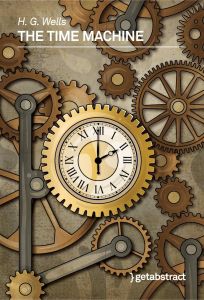
The Time Machine
- Science fiction
- Victorian literature
What It’s About
Humanity’s Dark Fate
There’s no denying that The Time Machine is an extraordinary work of imagination. More than 100 years after its initial publication in 1895, H.G. Wells’s tale of a nameless scientist who builds a time machine, travels to the year 802,701 AD and there encounters humanity’s descendants – the childlike Eloi and the monstrous Morlocks – continues to engage readers and inspire fellow science fiction authors. Still, The Time Machine is hardly light entertainment. In many ways a response to the popular utopian fiction of the period, Wells handily inverts a core belief of his day – namely, that scientific and technological progress would, inevitably, lead to a better tomorrow. Indeed, the novel’s decidedly pessimistic speculation about the ways humanity may evolve if it fails to face the most pressing social problems of the era – particularly, the exploitation of the working classes – offers a profound indictment of unchecked capitalism and the class divisions that roiled late 19th-century Victorian society.
Summary
About the Author
H.G. Wells (Herbert George Wells) was born in Kent, England, on September 21, 1866. The fourth child of shopkeeper and professional cricket player Joseph Wells and his wife, Sarah Neal, young Wells became a voracious reader at age seven, when an accident left him confined to his bed for several months. When an injury left Joseph unable to continue as a cricketer, Wells was apprenticed to a draper, where he worked 13 hours a day. His mother became a maid at Uppark — a country estate, where her son had access to its extensive library. There, he read the works of Plato, Voltaire, Swift and Daniel Defoe. In 1883, Wells became a pupil-teacher at Midhurst Grammar School. The next year, he won a scholarship to the Normal School of Science in London, where he studied biology under Thomas Henry Huxley – an advocate of Charles Darwin’s theory of evolution. While at school, Wells became a member of the pro-socialism Fabian Society, though he later criticized the group for not being radical enough in its aims. He also wrote for The Science School Journal and published a short story about time travel titled “The Chronic Argonauts.” In 1891, Wells married his cousin, Isabel Mary Wells. The pair separated in 1894, when Wells fell in love with Amy Catherine Robbins. Over the years, he engaged in affairs with a number of prominent women. He fathered a daughter, Anna-Jane, with writer Amber Reeves and a son, Anthony West, with novelist and feminist Rebecca West. In 1895, Wells published his first novel, The Time Machine, closely followed by The Island of Doctor Moreau (1896), The Invisible Man (1897) and The War of the Worlds (1898). These works established Wells’s fame as an author. In addition to fiction, the highly prolific Wells wrote essays, book reviews and several best-selling nonfiction works, including Anticipations of the Reaction of Mechanical and Scientific Progress upon Human Life and Thought (1901) and The Outline of History (1920). During World War II, he drafted “The Rights of Man,” which later became influential in the United Nations’ development of the Universal Declaration of Human Rights in 1948. Wells died in London of unspecified causes on August 13, 1946, at the age of 79.








Comment on this summary